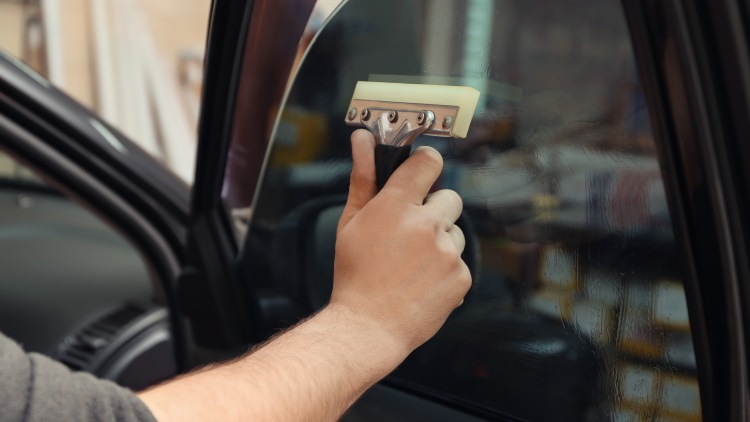
Depending on why or where you are deciding to apply window tint film, whether it is a vehicle, your home, business, or elsewhere, it is a convenient and attractive means to improve the ambience of an interior space at a low price. Reducing glare can keep your space cool during summer while retaining heat for you during winter, drastically reducing your monthly energy bill. Some films can even block ultraviolet rays from being absorbed by you, reducing the risk of certain skin cancers. It promotes privacy but allows some light to pass for your visibility.
Using the correct window tint film is vital because not all types are equal when considering the efficiency of their uses. Differing in the terms of material quality, cost efficiency, and effectiveness, it’s worth considerable effort in deciding among these categories of tinting film. Here are four of the main types of different window-tinting films and the considerable differences each of them offers.
Different Types of Window Tinting
Dyed Window Tint Film
Dyed window tint is the cheapest type when considering window tinting film, at the expense of functionality. Dye is applied to a layer of film aside adhesive that is then fitted to the window. This dye aids in blocking light rays and absorbs some of the solar heat, preventing its entrance into your interior space.
Additionally, the dyed film can look opaque. This helps provide the inside space some level of privacy while still allowing visibility inside.
On automobile windows, the dye will appear very dark in most applications. The dye typically fades over time, and the heat that is reduced by the various types of dyed film is not impressive. For this reason, dyed window tint film is used primarily for appearance only.
Metallic Window Tint Film
Used for the reduction of heat, this film reflects light and heat away from the internal area through tiny metallic particles embedded inside the film. Additionally, these particles (though invisible to the naked eye) improve the overall strength and durability of the window, making it less likely to shatter or scratch.
Metallic window tint film looks shiny from the outside. If utilized on a vehicle, one disadvantage of metallic film is its likelihood to interfere with cell and GPS transmission, and radio reception.
Many consumers choose metallic window tint film to go on their personal vehicles due to its reflective appearance. This aids in the reduction of theft and property damage.
Carbon Window Tint Film
This type of film typically delivers far better results when compared to dyed or metallic tint film. It doesn’t consist of metal so there is no cell or GPS transmission issue. The tint has a dark matte finish that produces an aesthetically pleasing look to the glass it is implemented on while preventing nearly 40% of the infrared beams from entering your internal area.
In other applications, while retaining its effectiveness in blocking heat and allowing an inside space to remain cool, it also serves in the reduction of sun bleaching to indoor upholstery, hardwood flooring and other items that may be damaged by the solar rays. Heating and air condition units will be used far less reducing your energy bills as a result and unlike dyed film, carbon film doesn’t fade.
Ceramic Window Tint Film
Being the highest quality in comparison to the other tint films, ceramic film is typically the most costly. This window film consists of a ceramic particle that is nonmetallic and nonconductive.
Though relatively new to consumers, this film has more than demonstrated its value in terms of its overall reliability and performance. Ceramic window film decreases from 45% up to 50% of the heat that penetrates through the windows in the form of infrared light, while providing the highest visibility day or night.
Like carbon film, the ceramic film allows maximum effectiveness in the functioning of communication systems, and all additional devices being operated from the interior space. It excels over the opposing films in its resistance to fading and glare and renders windows a high amount of resistance to shattering.
Ceramic film is also most efficient in its blocking of ultraviolet radiation, up to a 99% reduction in ultraviolet light from reaching into to your internal area.
Summary
Therefore, whether you are deciding to apply the window tint yourself or are using a professional window tint installer to apply it for you, ensuring that you are using the correct type of window tint film is both cost efficient and aesthetically pleasing.
Keep in mind that applying window tint yourself is time-consuming and difficult. If applied incorrectly it can also be very costly. Using a professional window tint installer is recommended.
There are many different choices to decide on and many of the installers will present you with their options and their benefits. Using the cheapest type of window tint isn’t usually the most cost-efficient in the end, but using the most expensive window tint in the incorrect way can likewise be considerably costly. There are many factors outside of this article to decide on before making a final decision on where and when window tint needs to or is applied.
Be sure to adhere to the regional laws and ordinances when applying window tinting to a vehicle. In most states, there are regulations in place that will depict the darkness or shade of your window tinting. Being sure to use the right window tint for the job can save you from a costly ticket and from the aggravation of being pulled over in the first place.

